If you’ve ever parked a green-and-yellow tractor next to a half-ton truck and thought, “What if John Deere built a pickup?”, you’re not alone. The 2026 John Deere Pickup is the talk of farm shows, forums, and group chats right now. To be clear up front: John Deere has not officially announced a consumer pickup truck as of today. What follows is a news-style roundup of credible rumors, industry logic, and what a real-deal 2026 John Deere Pickup could look like if (and that’s a big if) it hits the road.
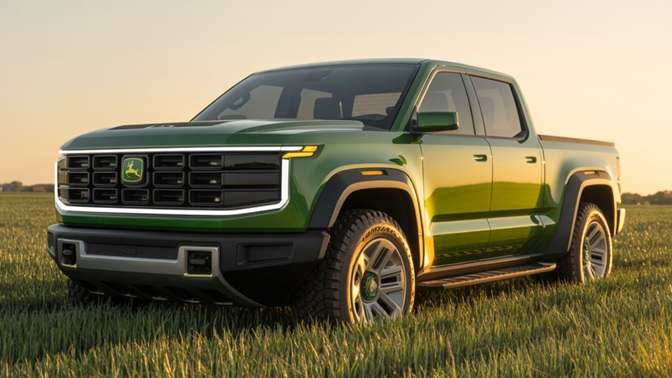
We’ll keep it simple and practical—American tone, easy to skim, with quick facts, tables, and straight talk.
- Status: Not officially confirmed by John Deere. Active rumor mill.
- Why now: Work-truck buyers want onboard power, smarter towing, and rugged interiors—right in Deere’s wheelhouse.
- Likely approach: Partnership with an established automaker or a contract manufacturer, rather than Deere building a new auto factory from scratch.
- Design vibe: Square-shouldered, farm-tough styling with unmistakable green-and-yellow accents.
- Powertrains: Gas turbo-six or V8, a high-torque diesel option, and at least one hybrid with serious onboard power.
- Price targets: Competitive with well-equipped half-ton rivals; think low-to-mid $50Ks to start, with work trims below and premium/HD trims well above.
- Availability: If real, expect a 2025 reveal and limited 2026 launch, focusing first on core work-spec buyers.
- Big question: Will it sell through John Deere dealers, auto dealers, or a blended model? Distribution is a major unknown.
Why a John Deere pickup makes sense
- Brand trust: Deere is practically synonymous with durability in rural America.
- Built-for-work DNA: Farm-first functionality could translate to a smarter bed, power take-off–style electrics, and jobsite-ready durability.
- Tech synergy: Deere’s telematics know-how (think JDLink/Operations Center in the ag world) could evolve into vehicle-side fleet tools—if they decide to integrate.
What to expect (if it happens)
- A tough, square body with clean lines and practical aerodynamics
- A bed that works as hard as you do: more tie-downs, 120V/240V outlets, handy steps, and cargo management
- A wash-it-out interior with big knobs, glove-friendly controls, and clever storage
- Towing and payload numbers that compete with mainstream half-ton trucks
- Modern driver-assist tech that helps, without being fussy
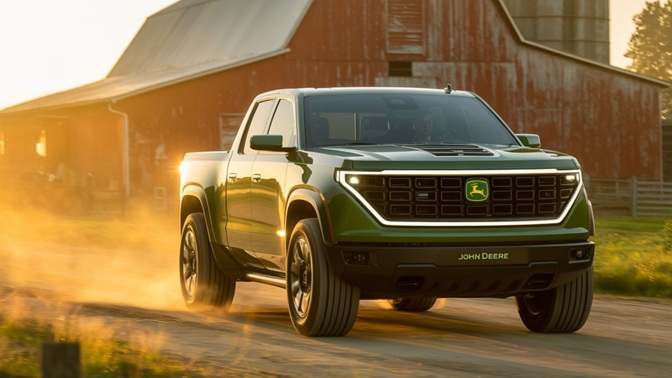
New Design- a farm-tough shape with modern polish
Think strong shoulders, a near-flat hood, and fenders you can see. If the 2026 John Deere Pickup materializes, expect it to lean hard into a squared-off silhouette that looks purposeful without going full retro. Signature Deere cues would be tasteful—no toy-truck vibes—likely limited to color accents, grille texture, and wheel details.
Design expectations
| Element | What we’d expect | Why it matters |
|---|---|---|
| Stance | Square, planted, with usable | Confidence on gravel, fields, two-tracks |
| Lighting | Slim LED DRLs, robust housings | Better night work, lower power draw |
| Bed | Multiple tie-downs, integrated steps, 120V/240V outlets | Real utility for tools and implements |
| Bumpers | Steel-friendly, sensor-integrated | Easy repairs, farm-tough practicality |
| Colors | Deere green/yellow accents, plus work | Fleet-ready and brand-right options |
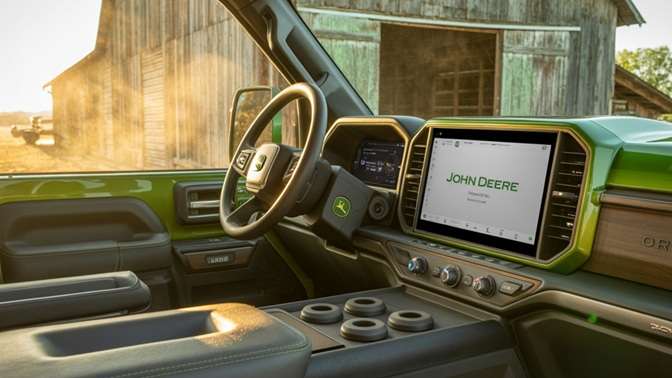
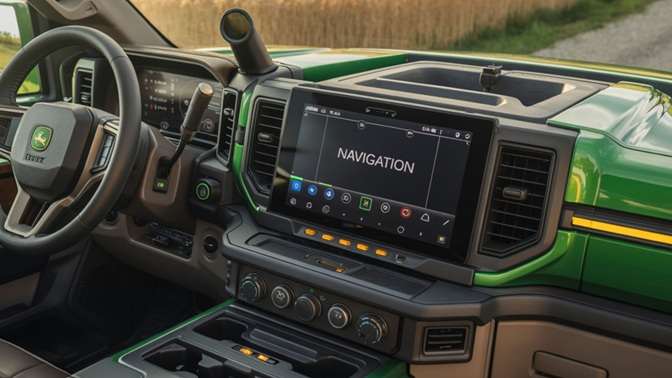
Interior & Comfort: Built for Boots
Farm chores don’t pause for nice weather. Expect a cabin that’s easy to clean and hard to rattle.
- Materials that shrug off mud and grit: durable cloth or vinyl standard; premium SofTex/leather on upper trims
- Big, logical controls: physical knobs and buttons for climate and tow/haul; touchscreen for cameras, maps, and apps
- Smart storage: deep bins, under-seat compartments, lockable console, and a phone charger that actually holds a phone
- Quietness: better sealing and insulated glass for long highway runs between fields and job sites
- Camera views that matter: bed cam, hitch cam, and perimeter views for trailers and tight access
| Trim | Seating/Materials | Screens |
|---|---|---|
| Work | Durable cloth/vinyl, rubber floors | 8–10″ infotainment, analog/digital cluster mix |
| Trail | Cloth/SofTex mix, all-weather mats | 12″+ infotainment, digital cluster |
| Premium | Leather-trimmed, heated/ventilated | 12–15″ infotainment, full digital cluster, HUD optional |
Powertrain and modern power
This is the heart of the rumor: not just what’s under the hood—but what that power can do for your tools.
- Gas turbo-six or V8: Bread-and-butter for most buyers—balanced towing and everyday drivability.
- Diesel option: A torquey inline-six or V6 diesel for serious towing and long-haul efficiency.
- Hybrid: A high-output hybrid 2026 john deere pickup engine that doubles as a mobile generator—ideal for welders, compressors, and saws on remote sites.
- Transmission: Modern 8–10 speed automatic with multiple tow/haul, off-road, and eco calibrations.
- 4×2 and 4×4: Most trims offering both; locker or advanced traction control on off-road packages.
Modern power (onboard generator/inverter)
- 120V and 240V outlets in bed and cab
- Configurable output to run tools or backup small farm operations during outages
- Smart thermal and noise management so it can power gear quietly at dawn
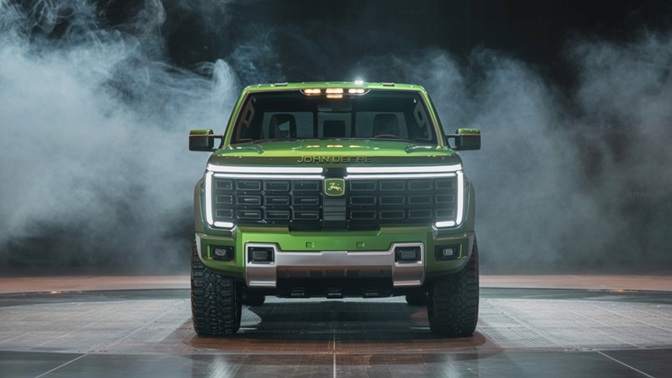
2026 John Deere Pickup specs
| Category | Half-ton target (est.) |
|---|---|
| Max towing | 11,000–13,500 lbs (properly equipped) |
| Max payload | 1,700–2,400 lbs depending on trim/options |
| Power | Gas: 350–420 hp; Diesel: 280–330 hp/450–600 lb-ft; Hybrid system total: 375–450 hp |
| Bed lengths | 5’8”, 6’6” (crew/double cab dependent) |
| 4×4 hardware | Low-range, optional locking rear diff; off-road shocks/skid plates on Trail trims |
| Onboard power | 2.0–7.2 kW class (output varies by battery/engine) |
Note: These are directional, not promises. Final ratings depend on partners, weight, aero, gearing, and certification.
Features that would land well with Deere fans
- Smart trailering: Trailer profiles, light check, jack-knife alert, transparent-trailer camera view
- Work lights: Bed, mirror, and perimeter LEDs with button control and app scheduling
- Upfitter-friendly wiring: Prewired switches and fused circuits for plows, winches, and auxiliary equipment
- Bed ecosystem: Integrated rails for racks, toolboxes, and ladder systems; stake pockets with real load ratings
- Connectivity: Basic telematics for small fleets; service reminders; remote lock, start, climate precondition
- Safety: Forward collision warning, automatic emergency braking, blind-spot with trailer coverage, 360 cameras, and adaptive cruise—standard or readily available
Rumors roundup (with confidence levels)
| Rumor | What it means | Confidence |
|---|---|---|
| Partner-built platform | Deere would join forces with a major automaker or contract builder | High (new auto plants aren’t weekend projects) |
| Diesel + hybrid lineup | Two-pronged powertrain play for torque and power export | Medium-high |
| Deere dealer involvement | Sales/branding through select Deere dealers in rural markets | Medium (regulatory/distribution hurdles) |
| JDLink-like fleet tools | Light-duty telematics that talk to Deere’s ecosystem | Medium |
| Limited first-year run | Start small, grow capacity if demand is strong | Medium-high |
| HD variant fast-follow | Three-quarter-ton class or chassis-cab after half-ton | Low-medium (depends on first-year success) |
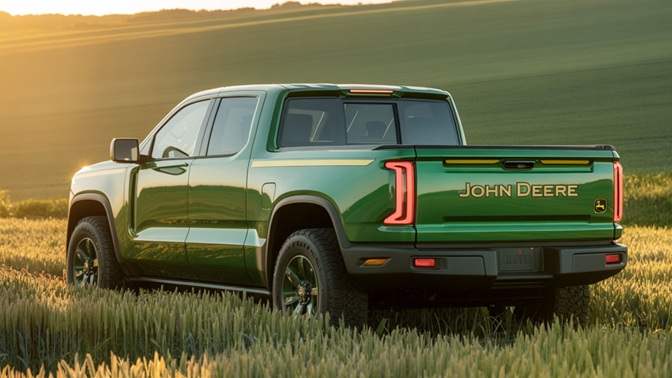
So, what would it cost?
If 2026 john deere pickup price goes premium-work instead of bare-bones, expect pricing to land near the heart of the half-ton market—competitive, not bargain-basement.
| Trim (est.) | Drivetrain | Est. starting price |
|---|---|---|
| Work | 4×2 or 4×4 | $44,000–$49,000 |
| Trail | 4×4 | $54,000–$60,000 |
| Premium | 4×4 | $62,000–$72,000 |
| Diesel option | 4×2/4×4 | +$6,000–$10,000 over gas |
| Hybrid w/ high-output power | 4×4 | +$3,500–$6,000 over base gas |
Options that push the needle
- Max trailering package (cooling, axle ratio, hitch gear)
- Off-road protection (skids, all-terrain tires, recovery points)
- Tech & safety bundle (360 camera, HUD, advanced assists)
- Cold weather package (heated everything, remote start, heated wipers)
- Bed utility (power tailgate, bed step system, cargo management rails)
Competitive landscape
- Ford F‑150: Huge lineup, Pro Power Onboard set the tone for jobsite electricity.
- Chevy Silverado/GMC Sierra: Strong towing, new interiors, wide dealer footprint.
- Ram 1500: Ride comfort and cabins that feel a class up.
- Toyota Tundra: Twin-turbo V6 and hybrid punch.
- Rivian R1T/F-150 Lightning: EV torque and quiet power—2026 john deere pickup hybrid generator angle would speak to power tools without range anxiety.
Distribution: the elephant in the room
If a 2026 John Deere Pickup is real, how it reaches buyers is as important as the truck itself.
- Dealer strategy: 2026 john deere pickup network excels at ag/construction equipment—but passenger vehicles have different rules. A co-branded approach with an auto partner could solve that.
- Service: Parts availability and service training must be bulletproof, especially for rural owners who rack up miles on tough roads.
- Regulations: Light-duty pickups require federal safety, EPA/CARB certification, and compliance infrastructure—another signal a partner would be involved.
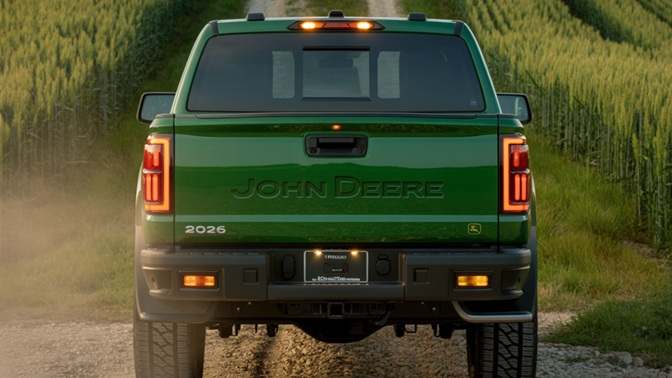
Availability And Timing
A plausible timeline—if (and only if) the project is underway:
- Reveal: Late 2025 at a major farm show or auto show
- Order banks: Early-to-mid 2026 for initial configurations
- First deliveries: Mid-to-late 2026 in priority markets
- Wider rollout: 2027 model-year expansion with more trims and powertrains
How to read the tea leaves?
- Watch for supplier whispers: Seating, lighting, or bed hardware suppliers sometimes hint at new contracts.
- Look for regulatory breadcrumbs: EPA/CARB certification lists, NHTSA filings, and crash test schedules can tip off new models.
- Follow Deere’s executive comments: Investor day slides and earnings Q&A sometimes tease adjacent markets.
FAQ/ Frequently Asked Questions
Q.1. Is the 2026 John Deere Pickup confirmed?
No. As of now, it’s a well-circulated rumor with logical business cases—but not an official product.
Q.2. Would it be electric?
Full EV seems less likely for rural duty in 2026; a hybrid with serious onboard power feels more on-brand. A diesel option for towing also makes sense.
Q.3. Where would it be built?
Unknown. A partner plant in North America (Mexico/USA/Canada) would be the efficient route.
Q.4. Can I order one?
Not yet. If 2026 john deere pickup or a partner confirms it, expect a staged launch with limited early allocations.
Q.5. Will it be more expensive than an F‑150 or Silverado?
Likely similar to comparably equipped work or premium trims; Deere could position it as “pay for what you need, not fluff.”
Balanced take: head vs. heart
- Head: Launching a pickup is a capital-intensive, regulation-heavy effort. Partnerships are essential.
- Heart: The idea of a Deere-branded pickup that’s unapologetically built for fields, fence lines, job sites, and small-town Main Street is compelling—and the customer base is there.
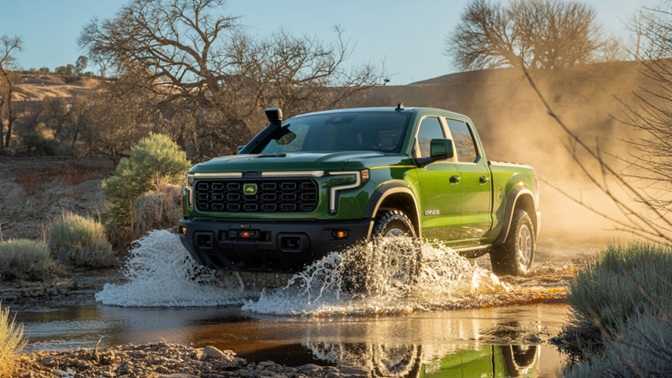
What a “right” 2026 john deere pickup would do on day one
- Tow with confidence, without demanding a maxed-out spec sheet
- Power tools and small equipment straight from the bed—no generator juggling
- Take a beating and clean up easy
- Keep tech helpful and out of the way
- Offer dealer service hours that respect planting/harvest schedules and construction seasons
A 2026 John Deere Pickup—often misspelled online as “2026 John Derre Pickup”—wouldn’t need to reinvent the truck. It would need to refine it for how rural America actually works: less sizzle, more steak. Think square-shouldered design, a dead-simple interior that still feels modern, tow-focused engines with a hybrid that doubles as a jobsite generator, and a bed that puts utility first.
Related Post




